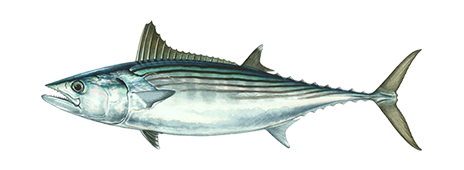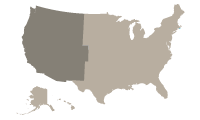
Pacific Bonito
The Pacific bonito is restricted to the eastern Pacific Ocean.

Region
West
Catch ease
Easy
Habitat
Ocean
How to identify a Pacific Bonito
Distinguishing the Pacific bonitos from each other and from other Pacific Scrombroid species has been confusing for many anglers. Superficially, many of the species resemble each other very closely. The Sarda species differ from all other bonitos (with the exception of the so-called “slender tuna”) in having no teeth on the tongue and having a straight intestine with no fold in the middle. The Sarda species are not normally confused with Allothunnus and can be easily distinguished by the number of gill rakers: Sarda has 8-27 on the first arch (S. lineolata, 8-13; S. chiliensis, 23-27) whereas Allothunnus had 72-80. The Sarda species are further characterized by the first dorsal fin which has 17-19 spines. Like all bonitos (with the exception of dogtooth tuna) Sarda species do not have a swim bladder. The northern population of Pacific bonito does not have any sort of stripes, lines, or spots on the belly.
Where to catch Pacific Bonito
The Pacific bonito is restricted to the eastern Pacific Ocean. Its range is divided into two distinct and separate populations which have led to two genetically different sub-species of Pacific bonito that look very similar to each other. Only the northern species of Pacific bonito can be found in the United States. The northern population ranges from Alaska to southern Baja and the Revillagigedo Islands off Mexico. The southern population ranges from Peru to Chile. The following list includes additional details on where to catch this fish:
How to catch Pacific Bonito
Bonitos are migratory, schooling, pelagic fishes. They feed on smaller pelagic fishes and on squid, usually near the surface. Fishing methods include surface trolling, casting, jigging, live baiting or use of a variety of small artificial lures. These fish are voracious eaters and provide incredible top-water strikes for anglers. Like most pelagic fish, this species is a scrappy fighter and capable of blistering runs. The flesh of the pacific bonito is lightly colored and excellent table fare. The following are fishing methods used to catch this fish:
Pacific Bonito lures, tackle & bait
The following are lures, tackle or bait that can be used to catch this fish:
